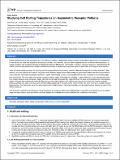Studying cell rolling trajectories on asymmetric receptor patterns
Author(s)
Lee, Chia-Hua; Bose, Suman; Van Vliet, Krystyn J.; Karp, Jeffrey Michael; Karnik, Rohit
DownloadKarnik_Studying cell.pdf (142.1Kb)
PUBLISHER_POLICY
Publisher Policy
Article is made available in accordance with the publisher's policy and may be subject to US copyright law. Please refer to the publisher's site for terms of use.
Terms of use
Metadata
Show full item recordAbstract
Lateral displacement of cells orthogonal to a flow stream by rolling on asymmetric receptor patterns presents an opportunity for development of new devices for label-free separation and analysis of cells[1]. Such devices may use lateral displacement for continuous-flow separation, or receptor patterns that modulate adhesion to distinguish between different cell phenotypes or levels of receptor expression. Understanding the nature of cell rolling trajectories on receptor-patterned substrates is necessary for engineering of the substrates and design of such devices.
Here, we demonstrate a protocol for studying cell rolling trajectories on asymmetric receptor patterns that support cell rolling adhesion[2]. Well-defined, μm-scale patterns of P-selectin receptors were fabricated using microcontact printing on gold-coated slides that were incorporated in a flow chamber. HL60 cells expressing the PSGL-1 ligand [3]were flowed across a field of patterned lines and visualized on an inverted bright field microscope. The cells rolled and tracked along the inclined edges of the patterns, resulting in lateral deflection[1]. Each cell typically rolled for a certain distance along the pattern edges (defined as the edge tracking length), detached from the edge, and reattached to a downstream pattern. Although this detachment makes it difficult to track the entire trajectory of a cell from entrance to exit in the flow chamber, particle-tracking software was used to analyze and yield the rolling trajectories of the cells during the time when they were moving on a single receptor-patterned line. The trajectories were then examined to obtain distributions of cell rolling velocities and the edge tracking lengths for each cell for different patterns.
This protocol is useful for quantifying cell rolling trajectories on receptor patterns and relating these to engineering parameters such as pattern angle and shear stress. Such data will be useful for design of microfluidic devices for label-free cell separation and analysis.
Date issued
2011-02Department
Massachusetts Institute of Technology. Department of Materials Science and Engineering; Massachusetts Institute of Technology. Department of Mechanical EngineeringJournal
Journal of Visualized Experiments
Publisher
MyJoVE Corporation
Citation
Lee, Chia-Hua, Suman Bose, Krystyn J. Van Vliet, Jeffrey M. Karp, and Rohit Karnik 2011Studying Cell Rolling Trajectories on Asymmetric Receptor Patterns. Journal of Visualized Experiments(48). Copyright © 2011 Journal of Visualized Experiments
Version: Final published version
ISSN
1940-087X